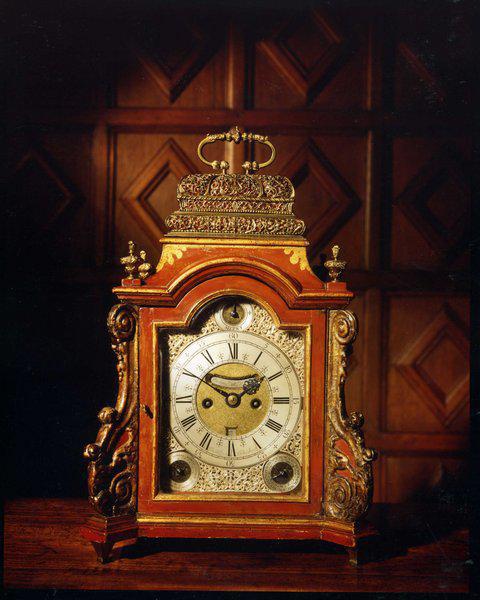An important, early-18th century, table clock by Daniel Quare
10474
The repousse, double basket top above a red-japanned oak case with canted corners, and replaced brass urn and flame finials and feet. The shallow broken arch containing a silver dial with strike/silent lever. The front decorated with solid silver filigree with one replaced section. The silvered-brass chapter ring signed "Daniel Quare, Londini Fecit". The dial with a mock pendulum aperture engraved "Exchange Alley, Cornhill", and a calender aperture for days of the month. Old repairs to hands. A silver subsidiary dial for months of the year and another for days of the week. The brass backplate engraved with a mask and an oosley bird. Replaced apron and pendulum. The eight day movement with replaced verge escapement, and restored quarter repeat on six bells. Movement numbered "D 32 Q" twice. English, first quarter of the 18th century.
This magnificent table clock is a fine example of the outstanding quality of mechanical craftsmanship prevailing at a time when English clockmakers were pre-eminent. The fine movement by Daniel Quare, "a worthy contemporary of Tompion", is un-commonly, numbered "D 32 Q" twice. Interestingly the British Museum have number '33' by Quare in their collection.
The case is a wonderful example of baroque workmanship, combining solid form and grandeur with lucidity and exhuberant embellishment.
It incorporates a wide variety of Continental designs that were highly fashionable at the time. The repousse double basket top is a feature found on many English clocks, although it was generally executed in the same metal as the filigree. The red-japanned decoration on the oak case is an early attempt to imitate sophisticated Far Eastern lacquer work, which was highly popular during Queen Anne's reign. The canted corners, brass urn and flame finials, and the overall shape of the case are influenced by earlier, Marot designs. The scrollwork on the four corners imitates a feature found on Italian clocks of this period. Unsurprisingly. The highly sophisticated and exotic design of the case has created speculation that this clock was made for a specific export market, although it is very difficult to prove with any degree of certainty.
This clock would have been prominently displayed and moved around the home. Undoubtedly commissioned by a wealthy patron, it would have cost as much in real-terms as its value today, representing the forefront of fashion and exotic taste of the time.
Daniel Quare
Old Clocks & Watches (Britten): "Daniel Quare (1647-1724) was admitted as a brother of the Clockmakers Company in 1671 and served as master in 1708.
Daniel Quare was a trusted man amongst the Quakers and, although he objected to taking the oath of allegiance, he served as clockmaker to George I. He was a worthy contemporary of Thomas Tompion.
During the latter part of his career he took into partnership with Stephen Horseman, who had been apprenticed to him, and the business was carried on at the same address under the title of Quare and Horseman.
After Quare's death, Horseman carried on under the name of the partnership until 1733 when he became bankrupt and the stock of the business was sold up."
18th Century
1725
England
Private Collection.
Illustrated in The Georgian Bracket Clock (Richard Barder), colour plate 20














